insight
工程技術,地產投資,信仰家園,時尚生活梵蒂岡,拉丁語中意為“先知之地”。早在西元4世紀,羅馬皇帝君士坦丁就在羅馬城西北角耶穌門徒聖伯多祿(聖彼得)殉難處建立了君士坦丁大教堂以示紀念;到了15至16世紀,君士坦丁大教堂被改建成如今的聖伯多祿大殿,成為天主教會舉行重大儀式的場所;公元756年,法蘭克王國國王丕平把羅馬城及其周圍區域送給教宗(教會史上稱為“丕平獻土”),後來就以此成立了半世俗政體型態的“教宗國”,範圍廣及意大利半島中部的大部分地區。
19世紀,歐洲的民族主義興起,意大利的民族統一運動使聖座於意大利的領土愈來愈少,半島北方的薩丁尼亞王國成為意大利統一運動的領導者之後,更主導成立了意大利王國。身為教宗國首府的羅馬城麵臨統一在即,法蘭西第二帝國皇帝拿破侖三世以身為“教會的保護者”的名義出兵保護羅馬城。1870年普法戰爭爆發,拿破侖三世把駐在羅馬的軍隊調回本國,使得意大利王國的軍隊得以順利開進羅馬城,意大利的統一正式完成,而教宗被迫退居羅馬城西北角的梵蒂岡宮中;之後曆代教宗均敵視新的意大利王國,甚至不準信徒參與意大利王國的公職。
1929年2月11日,意大利首相墨索裏尼掌握意大利政權後與教宗庇護十一世簽訂了《拉特蘭條約》,意大利承認聖座為主權國家,其主權屬教宗,其領土位於梵蒂岡城,稱為梵蒂岡城國,為中立國,其國土神聖不可侵犯。此條約正式解決了聖座與意大利政府間多年的糾紛。第二次世界大戰期間,梵蒂岡仍按照《拉特蘭協議》,保持中立,當時教宗為庇護十二世。
梵蒂岡城本身就是一件偉大的文化瑰寶,城內的建築如聖伯多祿大殿、西斯廷禮拜堂等都是世界上重要的建築作品,包含了波提切利、貝爾尼尼、拉斐爾和米開朗基羅等人的作品。梵蒂岡也擁有一個館藏豐富的圖書館,以及一個博物館,專門收藏具有曆史、科學與文化價值的藝術品。
梵蒂岡的日常生活具有濃厚的宗教色彩,每當星期日,天主教徒聚集在聖伯多祿廣場,中午12點,隨著教堂鍾聲響起,教宗在聖伯多祿大教堂樓頂正中窗口出現,向教徒們發表演說,梵蒂岡的瑞士衛隊每年5月6日在聖達馬索庭院(意大利語:Cortile di San Damaso)內舉行宣誓儀式,誦念5個多世紀來一直不變的誓詞,祈求天主保佑自己圓滿完成任務,效忠教宗可以獻出自己的生命。
聖伯多祿大殿(拉丁語:Basilica Sancti Petri,意大利語:Basilica di San Pietro in Vaticano),亦名聖伯多祿大教堂、梵蒂岡大殿、又譯作聖彼得大教堂,是位於梵蒂岡的一座天主教宗座聖殿,建於1506年至1626年,可能是世界最大的教堂,也是天主教會最重要的聖地之一。其占地23,000平方米,可容納超過六萬人。教堂中央是直徑42米的穹窿,頂高約138米,前麵有兩重用柱廊圍繞的巴洛克式廣場。意大利文藝複興時期的建築師與藝術家多納托·伯拉孟特、拉斐爾、米開朗基羅和小安東尼奧·達·桑加羅等都曾參與設計。廣場的設計人是貝尼尼。堂內保存有歐洲文藝複興時期許多藝術家如米開朗基羅、拉斐爾等的壁畫與雕刻。
地位
聖伯多祿大殿是羅馬的四座特級宗座聖殿之一(聖若望拉特朗大殿、聖伯多祿大殿、聖母大殿和城外聖保祿大殿),它也是梵蒂岡城中最主要的建築物。聖伯多祿大殿的穹頂構成羅馬城天際線的主要標誌。聖伯多祿大殿常被外界誤解是象征教宗駐地的“教宗寶座”所在,但教宗寶座其實是在聖若望拉特朗大殿——其亦為天主教羅馬教區的主教座堂。雖然如此,今日許多聖座禮儀與瞻禮還是在聖伯多祿大殿舉行,主要是因為這裏離教宗官邸較近、空間也較大、而且位於擁有獨立主權的梵蒂岡城之內。
聖彼得廣場



聖彼得大教堂 Saint Peter's Basilica


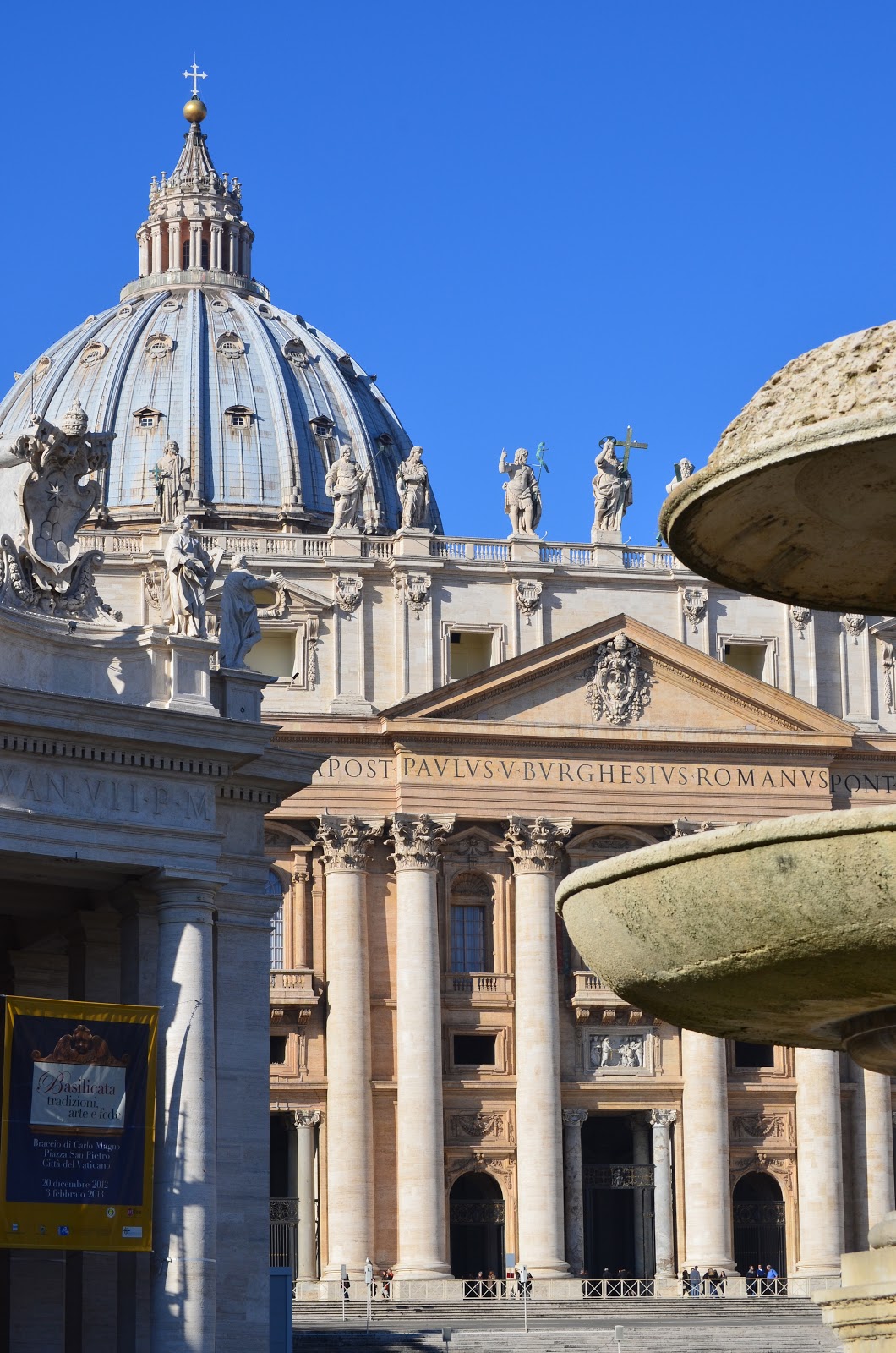
大殿正門前的聖彼得雕像

大殿正門前的聖保羅雕像Apostle St Paul's Statue


The Grave of Pope Gregory XIII


The Holy Door is opened only for great celebrations.
Narthex and portals
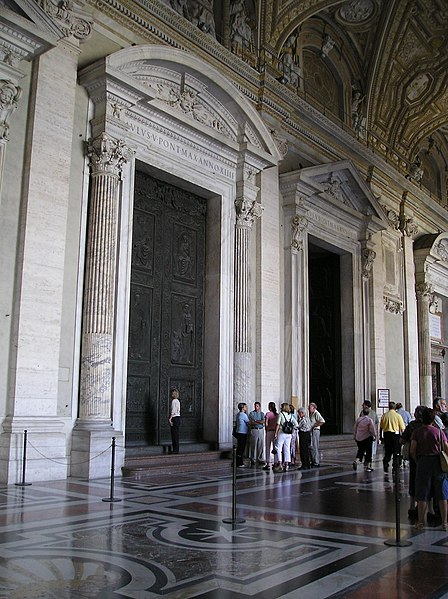
The altar with Bernini's baldacchino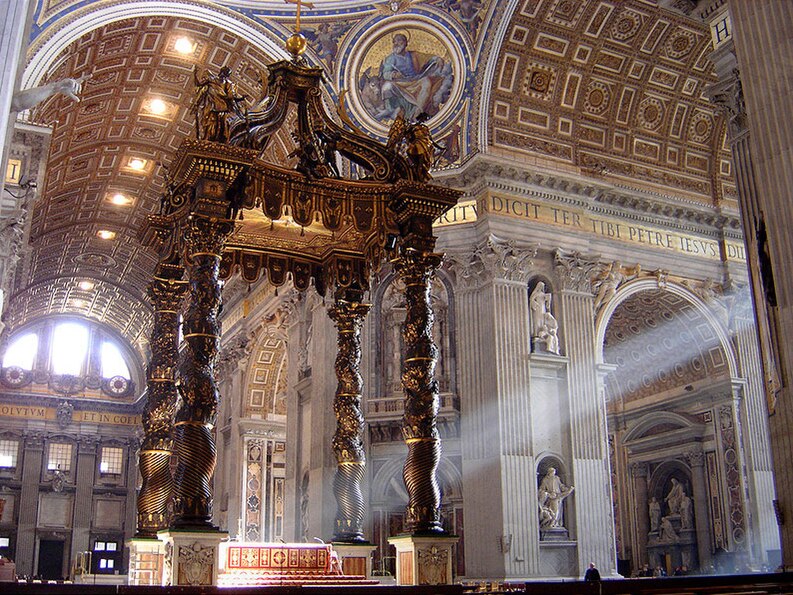






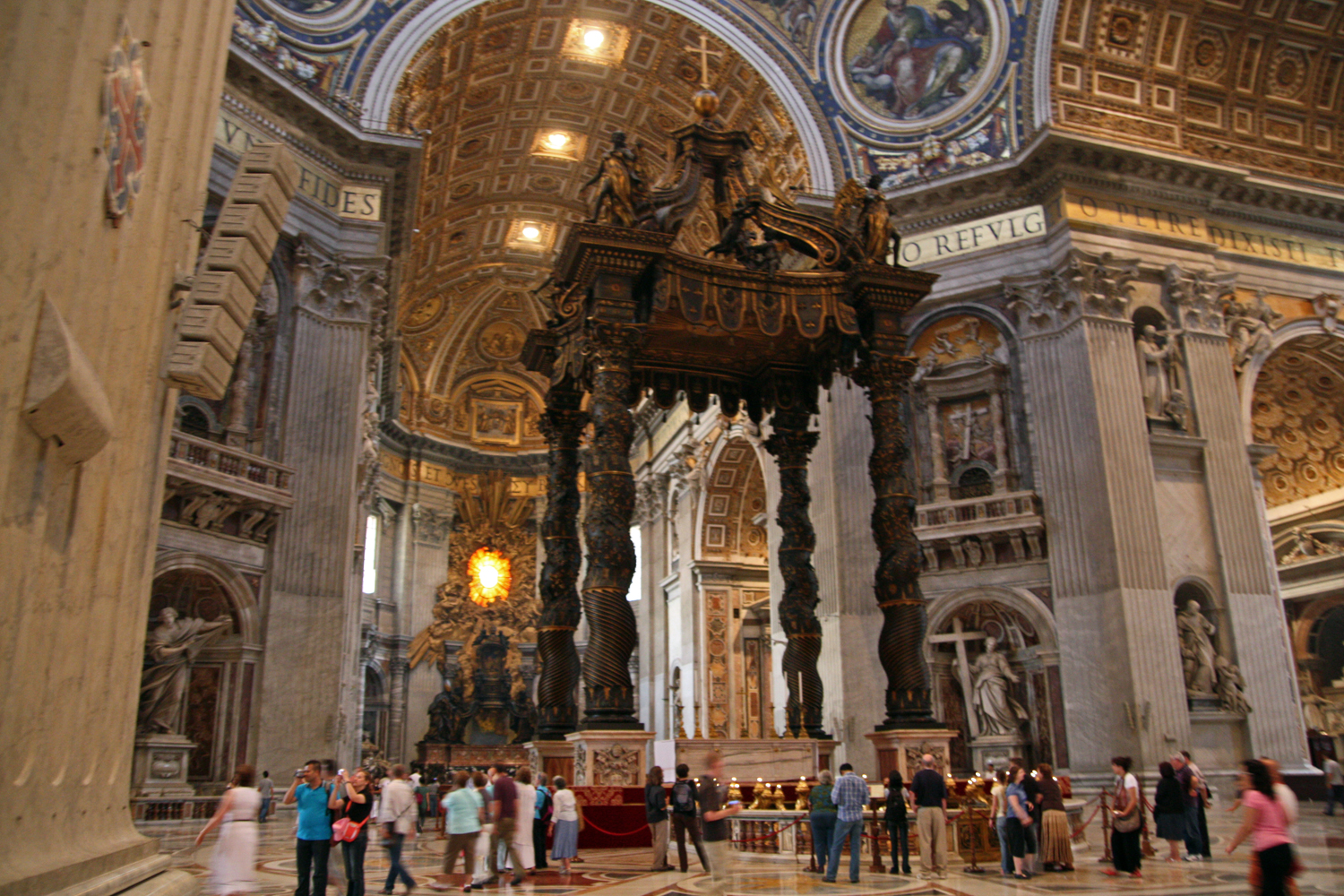
Bernini's "Cathedra Petri" and "Gloria"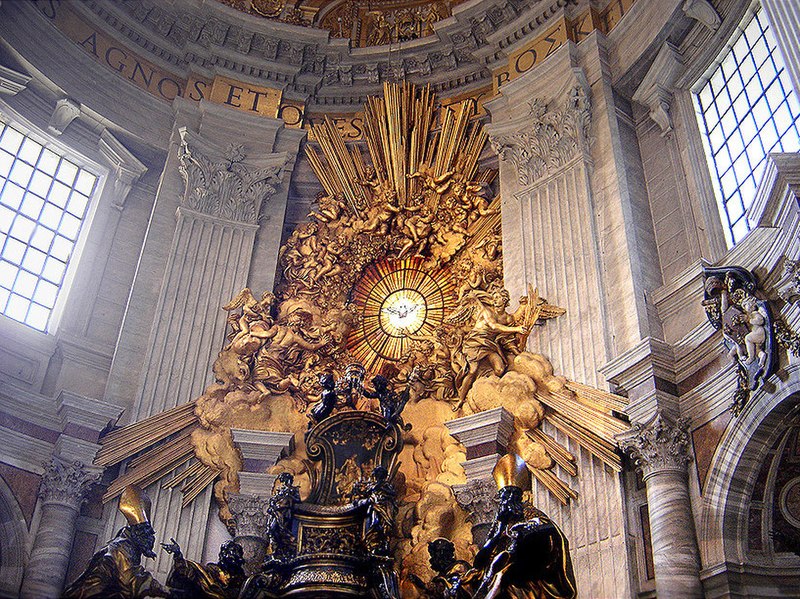

The dome was brought to completion by Giacomo della Porta and Fontana.



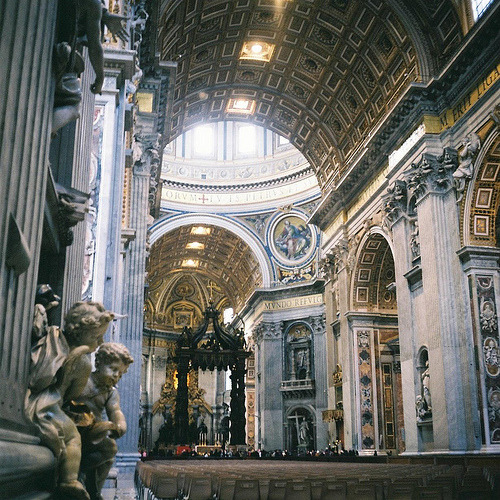

Private Chapel of the Canons of St. Peter's Basilica located just off the Canons sacristy
The Pietà (1498–1499) is a masterpiece of Renaissance sculpture by Michelangelo Buonarroti, housed in St. Peter's Basilica in Vatican City. It is the first of a number of works of the same theme by the artist. The statue was commissioned for the French cardinal Jean de Billheres, who was a representative in Rome. The sculpture, in Carrara marble,
was made for the cardinal's funeral monument, but was moved to its
current location, the first chapel on the right as one enters the
basilica, in the 18th century. It is the only piece Michelangelo ever
signed.
聖母憐子像(米開朗基羅)

The bronze statue of Saint Peter, attributed to Arnolfo di Cambio.

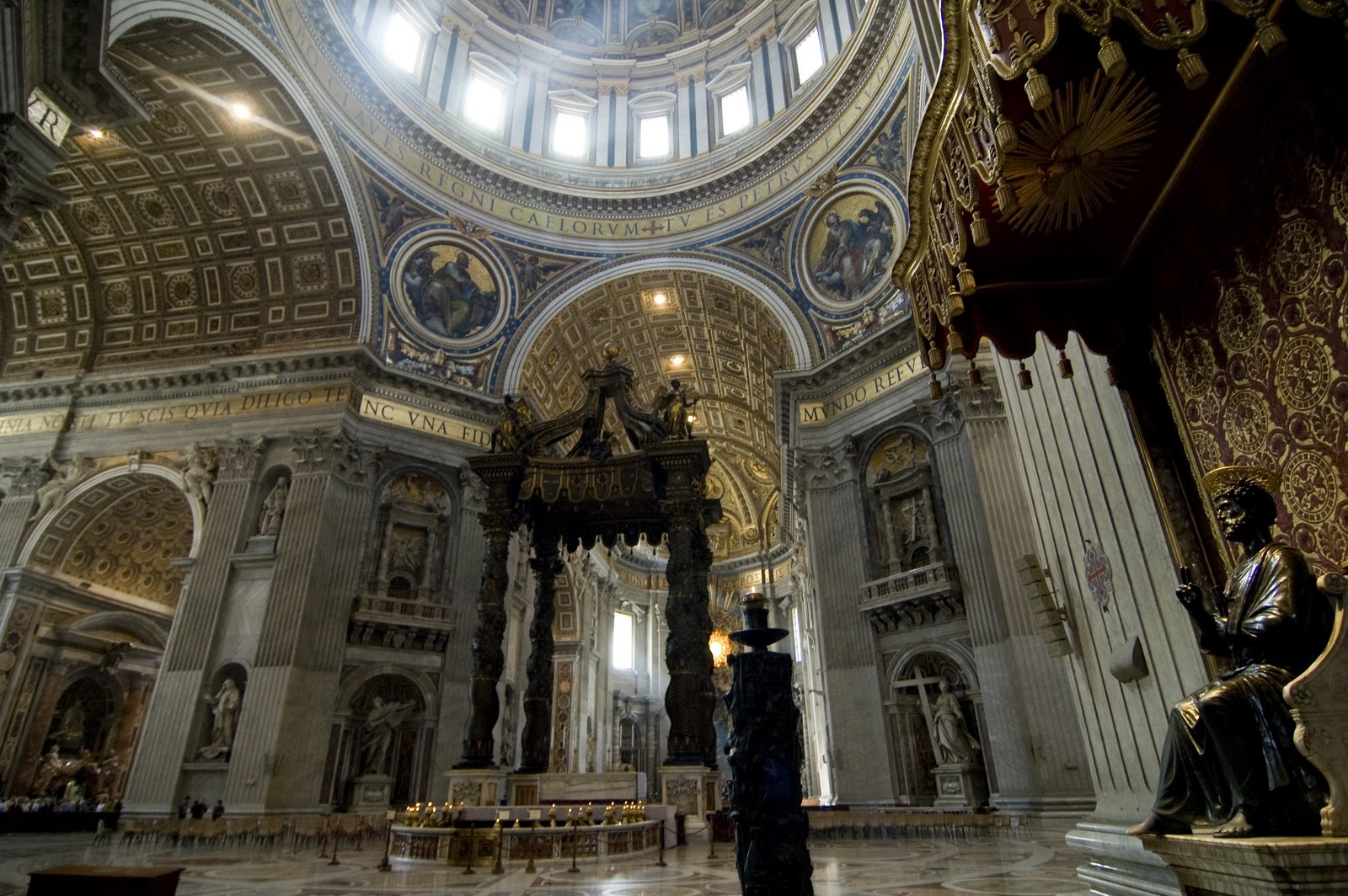



Truth, by Bernini. Her big toe is pierced by a thorn from Britain.
Statues in the piers of the dome
Saint Helena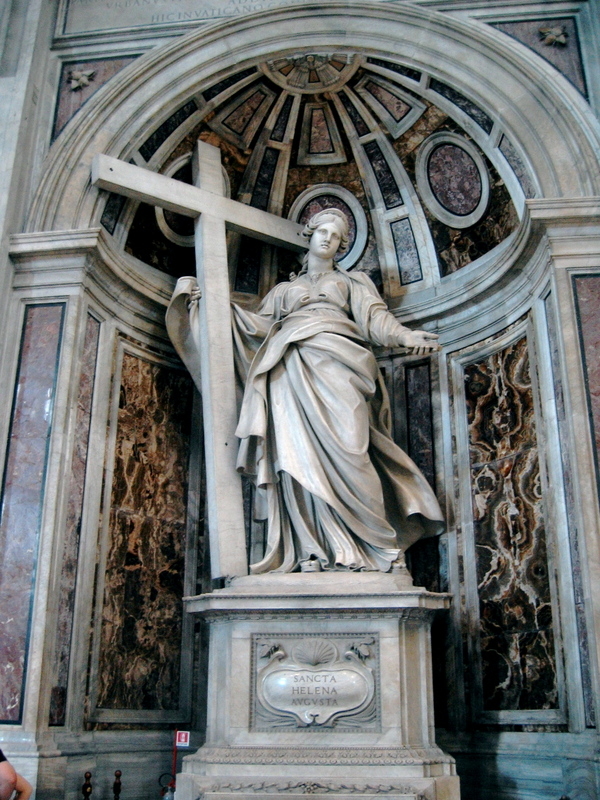
St Longinus
St Andrew
St Veronica
The Altar of Falsehood, on the left (south) side of the southeast pier
near the left transept.
This mosaic dates from 1725-27 and is based on a
painting by Roncalli, 1599-1604.
It depicts a scene from Acts 5:1-11,
where the couple Ananias and Sapphira lied to St. Peter and were struck
dead.


It was for this altar that Caravaggio painted St. Anne with the Virgin and Child. The painting was placed over the altar on April 14, 1606, but was removed two days later.
It was for this altar that the first mosaic altarpiece in the new basilica was made, unveiled September 29, 1628, the feast of St. Michael and the anniversary of Urban VIII's papacy.
The mosaic was replaced by another in 1758, after Guido Reni's Saint Michael in S. Maria della Concezione.

Monument to Pope Benedict XV


The Chapel of Saint Sebastian,painting
by Domenichino, 1628-31
mosaic by Cristofari, 1730-36.
Pier Paolo Cristofari, who executed Domenichino's painting into mosaic, was the Director of the Vatican Mosaic Studio from 1743-1755. He is responsible for many of the altarpieces in St. Peter's.
Under the altar
lies the remains of Blessed Innocent XI (1676-1689).

Altar of St. Thomas, under a mosaic showing the scene of his disbelief.
Under the altar are relics of Pope St. Boniface IV, who consecrated the Pantheon for Christian worship.


The altar of St Jerome closes the right-side aisle, as it is set at the
back of the pier of St Longinus. Since 2nd June 2001 it had been dedicated
to the Blessed John XXIII. Over it is the altarpiece with the Last Communion
of St Jerome, a mosaic copy realized in 1730 after the famous painting
by Domenichino, nowadays kept in the Pinacoteca Vaticana. Beneath the
altar is the body of Blessed Pope John XXIII, here transferred on 4th
June 2001. The four gilt bronze bas-reliefs were made by Novello Finotti,
who represented two moments in John's pontificate: the II Vatican Council
and UT UNUM SINT and two encyclicals MATER ET MAGISTRA and PACEM IN TERRIS.
Altar and tomb of Pope St. Gregory the Great
The subject of the altarpiece is St. Basil Celebrating Mass in the presence of the Arian Emperor Valens.
St. Basil is so involved in his devotion at Mass during the Feast of the Epiphany in 372 that he does not notice Emperor Valentius enter with his retinue.
The Chapel takes its name from the fact that the Liturgy of the Hours are celebrated here.
The mosaic
commemorates the Definition of Mary's Immaculate Conception.
(Dec. 8, 1854).
Its design was traditionally attributed to Giacomo della Porta (1540-1602),
but today it is thought to be the work of Carlo Maderno. It owes its name
to the fact that the canons of the basilica used to celebrate the Liturgy
of the Hours here as a choir. The gate of the chapel, usually closed,
is of exquisite workmanship.
The altarpiece, by Pietro Bianchi (1694-1740), shows the Virgin Immaculate in glory surrounded by angels and venerated by Sts. Francis of Assisi, Anthony of Padua, John Chrysostom. On December 8, 1854, on the occasion of the proclamation of the Dogma of the Immaculate Conception, Pius IX crowned the image of Mary. To mark the 50th anniversary of the Dogma, St. Pius X added a second crown, consisting of twelve stars, gleaming with twelve brilliants, donated by various nations.
Beneath the altar are the remains of St. John Chrysostom and relics of St. Francis and St. Anthony. The paschal candle stands on a black and white marble column with a porphyry base, in accordance with Paul VI's wishes.
The vault of the chapel, divided by four Corinthian pilasters, is decorated with fine gilded stucco ornaments on a white background, showing the Creation, the Crossing of the Red Sea, the Baptism of Jesus. In the dome are the Vision of the angels and the Elect of the Apocalypse. In the vault are shown: Habakuk and the angel, Daniel in the lions' den, David, Jonah inside the whale. In the lunettes, Deborah and Barak, Judith with Holofern's head, Moses and Aaron, Ozaziah and Uzziah and Jeremiah.
The dark wooden choir against the walls has a triple row of stalls, adorned with magnificent bas-reliefs and decorations; above it on each side are two historical organs.


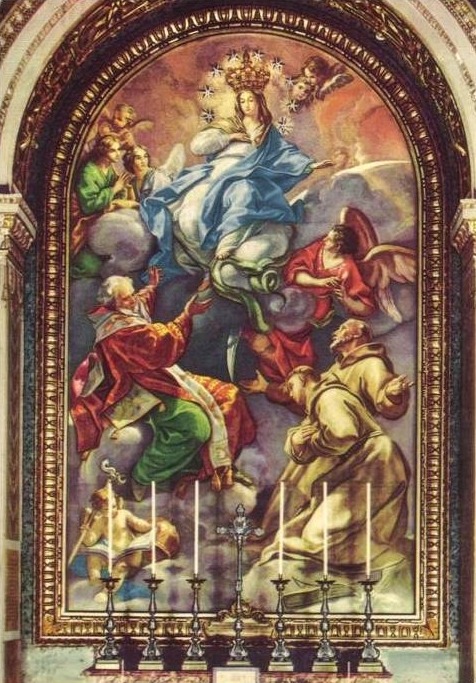
The mosaic altarpiece is the Presentation of the Virgin Mary in the Temple by her parents.
Below the altar is the body of St. Pius X (1904-1914), the last pope to be canonized.

"Monument to the Royal Stuarts" by Antonio
Canova, St Peter's Cathedral, Roma. Shows King James III The Old
Pretender (middle), his two sons Charles Edward (left) and Henry
Benedict (right).
Henry Benedict Stuart (11 March 1725 – 13 July 1807) was a Roman Catholic Cardinal, as well as the fourth and final Jacobite heir to publicly claim the thrones of England, Scotland, and Ireland. Unlike his father, James Francis Edward Stuart, and brother, Charles Edward Stuart, Henry made no effort to seize the throne. After Charles's death in January 1788 the Papacy did not recognise Henry as the lawful ruler of England, Scotland and Ireland, but referred to him as the Cardinal Duke of York.
He spent his life in the Papal States and had a long career in the clergy of the Roman Catholic Church, rising to become the Dean of the College of Cardinals and Cardinal-Bishop of Ostia and Velletri. At the time of his death he was (and still is) one of the longest serving Cardinals in the Church's history.
In his youth, Henry's father made him Duke of York (in the Jacobite peerage), and it was by this title that he was best known. Upon the death of his brother in 1788 Henry became known by Jacobites, and within his personal entourage, as Henry IX of England, although publicly he referred to himself as Cardinal-Duke of York nuncupatus.


Baptismal Font of the basilica

Altar of Transfiguration, painting
by Raphael, 1520


The Niccoline Chapel (Italian: Cappella Niccolina) is a chapel in the Apostolic Palace in Vatican City. It is especially notable for its fresco paintings by Fra Angelico (1447–1451)
Artist: Fra Angelico
Start Date: 1447
Completion Date:1449

St Peter Consacrates St Lawrence as Deacon,between and fresco



Fra Angelico, “Saint Lawrence receives the treasures of the Church”, a fresco (paint on wet plaster), c.1447


Saint Stephen (Koine Greek: Στέφανος, Stephanos; sometimes spelled "Stephan"), the first martyr of Christianity, was, according to the Acts of the Apostles, a deacon in the early church at Jerusalem who aroused the enmity of members of various synagogues by his teachings. Accused of blasphemy, at his trial he made a long speech fiercely denouncing the Jewish authorities who were sitting in judgement on him and was stoned to death. His martyrdom was witnessed by Saul of Tarsus (later renamed Paul), a Pharisee who would later convert to Christianity and become an Apostle.
The Stoning of Stephen

Thus castigated, the account is that the crowd could contain their anger no longer. However Stephen, seemingly now oblivious to them, looked up and cried "Look! I see heaven open and the Son of Man standing on the right hand of God!"[Acts 7:55]
To the Sanhedrin, this claim that the recently executed Jesus was
standing by the side of God (not sitting, as he is usually described in
New Testament texts) was such intense blasphemy that they covered their
ears so as not to hear it.[Acts 7:55]
They rushed upon Stephen, drove him outside the city to the place
appointed, and stoned him. At this time Jewish law permitted the death
penalty by stoning for blasphemy. The witnesses, whose duty it was to throw the first stones, laid their coats down so as to be able to do this, at the feet of a "young man named Saul",later to be known as Paul the Apostle. Stephen prayed that the Lord would receive his spirit and his killers be forgiven, sank to his knees, and "fell asleep".[Acts 7:58-60] Saul "approved of their killing him".[Acts 8:1]











四間拉斐爾客房(Stanze di Raffaello)是梵蒂岡宮內的一組客房,教宗住所的公共部分。它們以拉斐爾及其工作室創作的壁畫著稱。它們連同西斯廷禮拜堂內米開朗基羅的天頂畫,構成標誌羅馬文藝複興的盛大的壁畫係列。
康斯坦丁大廳
四個房間中最大的一個是康斯坦丁大廳(Sala di Costantino)。這些壁畫創作於教宗儒略時期,那時,拉斐爾本人已經去世。這個房間的主題是基督教戰勝了異教。壁畫通過羅馬皇帝康斯坦丁一世的生平反映這場鬥爭。這些壁畫是朱利奧·羅馬諾、吉昂弗朗斯科·班尼和若弗琳諾·迪·庫裏的作品。由於這些壁畫不是出自大師本人之手,它們不及相鄰房間的作品出名。出於一種奉承的悠久的傳統,拉斐爾的助手在畫中將教宗西爾維斯特的麵容描繪成當時的教宗克萊孟七世的麵容。
十字架顯聖
壁畫《十字架顯聖》描繪當康斯坦丁出征他的對手馬克森提烏斯時,巨大的十字架向他顯現的傳奇故事。在天空中出現十字架的異象,旁邊是希臘文“Εν τούτω νίκα”(藉此記號,你必征服)。

米爾維安大橋戰役
《米爾維安大橋戰役》朱利奧·羅馬諾表現的是發生於312年10月28日的米爾維安大橋戰役。
康士坦丁的捐贈
《康斯坦丁的捐贈》的靈感來自於著名的康斯坦丁的捐贈,這份偽造文件內容稱羅馬皇帝康士坦丁一世將羅馬一帶的土地贈送給教宗。

康斯坦丁的洗禮
最後一幅畫,《康斯坦丁的洗禮》,最有可能是吉昂弗朗斯科·班尼所畫,表現了這位皇帝在臨終前的情形。

伊利奧多羅廳
從東向西的第二個房間,是伊利奧多羅廳(Stanza di Eliodoro)。這裏的壁畫繪於1511年到1514年,房間也得名於其中的一幅畫。這個私人房間的主題是基督在天上保護教會。 四幅壁畫分別是:《伊裏奧多羅被逐出聖殿》、《保爾塞那的彌撒》、《良一世與阿提拉的會議》和《解救聖伯多祿》。其中前兩幅壁畫, 拉斐爾將他的讚助人教宗儒略二世畫成了參與者或觀察者;第三幅繪於儒略死後,包括他的繼任者良十世的肖像。
與簽字廳相比,拉斐爾的風格在此有所改變。與教宗圖書館的靜態圖像不同,取而代之的是戲劇性的敘述描繪,他的做法是,最大限度地提高壁畫的表現效 果。他描繪較少,較大的人物,因此他們的行為和情緒 對觀眾有更直接的影響,他使用舞台燈光效果來突出某些人物,和加劇緊張局勢。
伊裏奧多羅被逐出聖殿
拉斐爾的《伊裏奧多羅被逐出聖殿》取材自馬加比二書(3:21-28) 關於伊裏奧多羅,受命搶奪保存在耶路撒冷聖殿的
珍寶,但是受到阻止,因為天使答應聖殿祭司的禱告,鞭打入侵者,一個天使般的騎手從聖殿將其追趕。比起簽字廳內拉斐爾的早期壁畫,這幅畫具有更多的戲劇
性。雖然焦點是正在禱告的祭司這個靜止的人物,伊裏奧多羅和天使向前衝入空中,似乎要飛出畫麵。在左側,儒略二世由瑞士衛隊抬在椅子上,目擊了這一事件。
在這裏也是指儒略防止世俗領袖篡奪教廷領土的鬥爭。

保爾塞那的彌撒
《保爾塞那的彌撒》描繪了一位波希米亞牧師故事,他在1263年在彌撒過程中看到麵包開始流血,於是停止了對化質說教義的
懷疑。被血染紅的布成為聖物,在奧爾維耶多附近小鎮;儒略二世訪問奧爾維耶多,並在1506年為此聖物祈禱。這位教宗被描繪成一個彌撒的參與者和奇跡的見
證者;他跪在祭台的右邊,Curia 的成員站在他身後。拉斐爾從事件中的參與程度來區分“真正的”13世紀的見證人與教宗同時代的見證人。

良一世與阿提拉的會議
《良一世與阿提拉的會議》描繪了曆史上有名的良一世和阿提拉的會議,包括聖伯多祿和聖保祿在天空持劍的圖像。拉斐爾一個充
分發展的繪圖顯示他計劃將教宗描繪成儒略的麵容 - 在背景中;當良十世成為教宗時 -
他必須鼓勵藝術家將教宗描繪在前方中央的位置,並使用自己的肖像。

解救聖伯多祿
《解救聖伯多祿》分為三段,描繪了使徒行傳十二章所記載的聖伯多祿被一位天使解救出獄的故事。它象征著基督牧者的力量逃脫
人類的限製。儒略二世在升任教宗之前擔任樞機主教時,領銜教堂就在聖伯多祿鎖鏈堂,所以這幅畫既是概指教宗製,又是特指儒略。這幅壁畫是一種對光線的研
究:天然的的月光,人工的火炬光,以及上帝提供的天使光。當然,後者的光優於其他兩種光。

簽字廳
首先用拉斐爾壁畫裝飾的是簽字廳(Stanza della segnatura)。它曾是儒略二世的圖書館,宗座聖璽最高法院曾設於此處。藝術家的概念是,帶進古代精神與基督教的和諧,以及反映儒略二世的圖書館的內容:神學、哲學、法學和詩歌四大主題。這個房間的主題是世俗智慧與屬靈智慧的和諧,以及文藝複興人文主義者感知的基督教與希臘哲學之間的和諧。智慧的主題很適合這個房間,因為此處曾是宗座聖璽最高法院的會議室,大多數重要的教宗文件都是在此簽字蓋章。
聖體的辯論
拉斐爾的第一幅壁畫《聖體的辯論》創作於1508年或1509年。在這幅作品中,拉斐爾描繪的教會的形象,跨越天與地。

雅典學院
1509年底,拉斐爾開始在《聖體的辯論》對麵的牆上,創作第二幅壁畫《雅典學院》。整個房間解釋為從古典哲學到真正的宗教,以及從前基督教世界到基督教的運動。這也許是拉斐爾最著名的一幅壁畫。

帕那蘇斯山
拉斐爾在150年底或1510年初開始創作第三幅壁畫《帕那蘇斯山》。在古代神話中,那裏是阿波羅和繆斯女神居住的地方,以及詩歌的家鄉。在壁畫中,阿波羅和繆斯女神被古代和拉斐爾時代的詩人所環繞。

三德像
第四幅壁畫《三德像》繪於1511年。所謂“三德”,是指剛毅、審慎和節製。

博爾戈火災廳
博爾戈火災廳(Stanza dell'incendio del Borgo)得名於壁畫《博爾戈火災》,這幅畫描繪良四世十字架的記號撲滅羅馬博爾戈區(靠近梵蒂岡)的熊熊大火。這個房間準備作為儒勒的繼任者良十世的音樂室。壁畫描繪了教宗良三世和良四世的生平事跡。房間裏另外三幅壁畫是《良三世的誓言》、《查理大帝加冕》和《沃斯提亞戰役》。《博爾戈火災》是由拉斐爾設計構圖,但是由他的助手執行。另外三幅畫沒有他的指導。
良三世的誓言
800年12月23日,教宗良三世麵對他的前任教宗哈德良一世的侄子對他提出的指控進行宣誓。這一事件在壁畫《良三世的誓言》中得到展現。
查理大帝加冕
《查理大帝加冕》表現查理大帝在800年聖誕節加冕成為神聖羅馬皇帝的情景。

博爾戈火災
《博爾戈火災》描繪了847年在羅馬博爾戈區發生的一次火災。根據天主教會傳統,教宗良四世用他的祝福控製了火勢。

沃斯提亞戰役
《沃斯提亞戰役》的靈感來自於良四世於849年在沃斯提亞戰役中戰勝了撒拉遜人。








